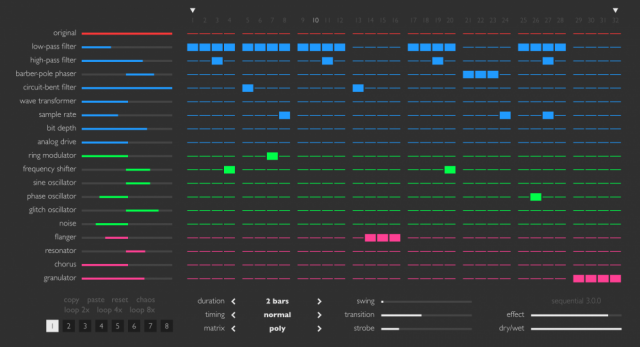
SineVibes has released Sequential 3.0, the latest version of their polyphonic multi-effect sequencer.
Sequential is a dynamic multi-effect that allows you to trigger different processing and synthesis algorithms in a rhythmical fashion. It features a total of 19 fine-tuned effects that filter, distort, reshape, stutter and even generate audio.
Here’s what’s new in Sequential 3.0:
- New interface with a 25% more compact layout, animations, rendered on the graphics adaptor.
- New audio engine with hardware-accelerated math and up to 2x less processor strain.
- Sequential is now polyphonic, can trigger multiple effects at once.
- 8 instance snapshots for realtime switching or host automation.
- New effects: flanger, resonator, three-voice chorus, granulator, analog drive.
- Steeper -24 dB/octave high-pass filter.
- Reworked circuit-bent filter algorithm with a resonant pre-filter stage.
- Reworked barber-pole phaser effect with feedback and bipolar frequency control.
- Reworked sine, phase, glitch oscillators with bipolar modulation depth controls.
- New user manual with detailed effects descriptions.
Sequential works with Logic, GarageBand, Live, ReNoise, Reaper, Studio One, Digital Performer and other software that supports Audio Unit effect plugins. It comes in 32/64 bit format for Intel Macs running OS X 10.6 or later, and supports Retina screen resolution.
Sequential is available via SineVibes for US $49. Audio demos are avaialble at the site.
If you’ve used Sequential, let us know what you think of it!

SINEVIBES, RELEASE FOR WINDOWS! PLEASE!
Dont’ hold your breath.
Developers go where the money is. iOS is the hottest platform now for music apps, followed by OS X and then Windows.
Also they use the apple developer libraries, and that’s why they don’t do windows. It would be a complete rewrite to port it to a non apple OS
You are correct, Sir. We use Core Animation for graphics and Accelerate for math. Both frameworks are universal for OS X and iOS, almost all code can be shared between our apps and plugins. Put simply, we can use 100% of what Apple’s hardware can offer, not a “common average” of several different platforms. We are not “limited” – we’re focused 🙂
please look in to Mantle on AMD platform, the APU is the future
you have a Large windows community Watling for your product
if you can look past you limited focus
——–your
You’re not focused, you’re lazy.
he said win….. 🙂